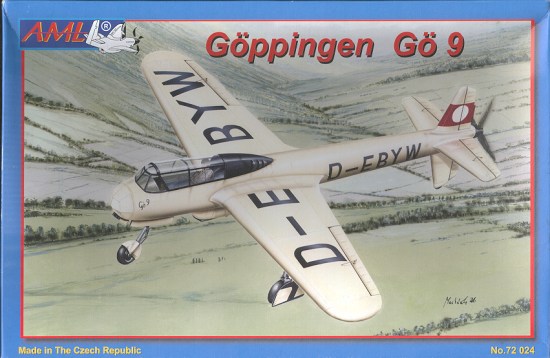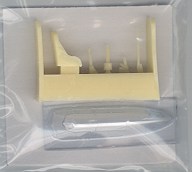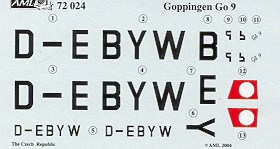
| KIT: | AML 1/72 Göppingen Gö-9 |
| KIT #: | 72024 |
| PRICE: | $19.98 (17.96 at Squadron) |
| DECALS: | One option |
| REVIEWER: | Scott Van Aken |
| NOTES: | Short run kit with resin parts and vacuformed canopy. |

| HISTORY |
The Gö-9 was basically a technology demonstrator for the upcoming Do-335 'Pfiel'. It had to be shown that a buried pusher engine arrangement with the cruciform tail would be a stable and viable platform for a high performance aircraft. Dornier contracted the construction of the aircraft to Dr. Ulrich Huter and his company, whose design looked surprisingly like a small Do-335. It was powered by the Hirt, 80 hp air-cooled engine. First flight was in the summer of 1940 and many test flights were undertaken between then and mid-1941 when the project was terminated. The fate of this interesting little plane is unknown, but it was probably scrapped.
| THE KIT |
 AML
has done some interesting aircraft in the past, but I believe this is their
first in-roads into the fascinating subject of prototype aircraft. There is
one sprue of dark green plastic with very good detailing. Since the Go-9
was basically a wooden plane, there isn't a mass of surface detail. In
fact, you could call it downright austere!
AML
has done some interesting aircraft in the past, but I believe this is their
first in-roads into the fascinating subject of prototype aircraft. There is
one sprue of dark green plastic with very good detailing. Since the Go-9
was basically a wooden plane, there isn't a mass of surface detail. In
fact, you could call it downright austere!
No flash, no sink areas
and the only ejector pin towers are on the wings and need to be removed
before construction. The interior is equally austere with a floor, seat and
control stick. Both the seat and control stick are resin. Also in resin are
two mass balances for the aileron, a pitot tube, and a prop hub. An
additional 'thing' is on the resin sprue but not shown in the instructions.
The four props have to be glued onto the resin hub and I'm hating that as I
don't like  separate blades and
hub, especially when there is no spinner to cover them up! Two vacuformed
canopies are provided. I appreciate the spare as there are times when I
need one. A couple notes of interest. One is that the gear doors are molded
in the down position, the landing gear struts seem rather simple (though
for a plane like this, perhaps they were) and the wheels have no real
detail, looking a bit like those from toys (though again, they may have
actually looked like that). My attempts at finding decent photos via the
'net were not very successful.
separate blades and
hub, especially when there is no spinner to cover them up! Two vacuformed
canopies are provided. I appreciate the spare as there are times when I
need one. A couple notes of interest. One is that the gear doors are molded
in the down position, the landing gear struts seem rather simple (though
for a plane like this, perhaps they were) and the wheels have no real
detail, looking a bit like those from toys (though again, they may have
actually looked like that). My attempts at finding decent photos via the
'net were not very successful.
 Instructions are nicely done
with 6 nicely drawn construction steps. Color information is provided,
giving generic and RLM shades. An additional chart provides FS, Humbrol,
Gunze, Model Master and Agma references. The instructions show that
extensions for the exhaust that run out the bottom of the aircraft must be
fabricated by the builder from stretched sprue (or maybe those are supposed
to be engine cylinders). No nose weight recommendation is provided, though
you know it will need some. There are markings for but the one prototype
and they appear to be superbly printed and quite thin. The overall color of
this is RLM 05 Cream and the only marking option is to paint the nose a
dark grey or black as was done for later flights. The color and markings
page on this sheet is in full color, which is quite a nice touch.
Instructions are nicely done
with 6 nicely drawn construction steps. Color information is provided,
giving generic and RLM shades. An additional chart provides FS, Humbrol,
Gunze, Model Master and Agma references. The instructions show that
extensions for the exhaust that run out the bottom of the aircraft must be
fabricated by the builder from stretched sprue (or maybe those are supposed
to be engine cylinders). No nose weight recommendation is provided, though
you know it will need some. There are markings for but the one prototype
and they appear to be superbly printed and quite thin. The overall color of
this is RLM 05 Cream and the only marking option is to paint the nose a
dark grey or black as was done for later flights. The color and markings
page on this sheet is in full color, which is quite a nice touch.
| CONCLUSIONS |
Personally, I love this kind of kit. By that I mean prototypes and generally unusual subjects. The kit looks deceptively simple to build, though I have been fooled before. Regardless, I plan on giving it a good go and you'll be able to read the results in these pages in the near future. If you like the unusual and something that will be what looks like fun to build, then this one is for you!
You can find this kit and many others at

If you would like your product reviewed fairly and quickly by a site that has nearly 300,000 visitors a month, please contact me or see other details in the Note to Contributors.